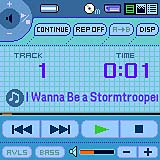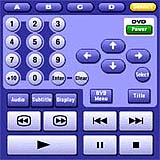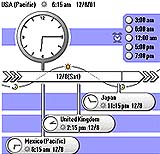OverviewThe PEG-T665C, to give its full name, is Sony's latest high-end color handheld. It has all the hallmarks of a good Sony device, including a hi-res color screen, a Jog Dial, a Memory Stick slot, and 16 MB of RAM. However, the T615C had all of those, too, and Sony isn't one to rest on its laurels. The T665C adds an MP3 player and a processor that is twice as fast.
ScreenThere was a lot of hope that this model would have a virtual Graffiti area like the one on the NR series. However, this turned out to not be the case. I suspect Sony left it out because it would drain the battery too much.
The screen is an improvement over the one on the T615C in one important way. The T615C's screen was pretty good but it was a bit weak in displaying some colors, especially reds. The T665C doesn't have any such problems at all. It can display 65 thousand colors that look pretty close to the originals, though not exactly. Reds look very good. Don't judge too much from the picture I included with this review; the actual screen looks a lot better.
You'll still need to have the backlight on much of the time you are indoors, unless you are in a quite brightly-lit room. Outdoors, the backlight becomes unnecessary. The T665C looks fine in direct sunlight and much of the time I'm outdoors I can't tell if the backlight is on or off.
It has an on-screen slider to set the backlight brightness. There is no way to adjust the contrast, but you don't really need to.

The only downside to having an audio player is it uses a lot of power. There is no doubt that playing a lot of MP3s makes a major hit to the batteries. Still, Sony has done all they can to minimize this. The DSP uses less power than doing the same job with a general-purpose processor and the Hold switch on the left side of the handheld turns off the screen but still leaves the device on and capable of playing music.
With the screen on, Sony says you get about one hour and thirty minutes of continuous audio. With the screen off, you can increase this to about four hours and thirty minutes.
The AudioPlayer app does everything you would expect it to do. It pulls files directly off the Memory Stick, displays them in a list, and lets you play, fast forward, and reverse through them. You can play music in the background while you do other things with your handheld.
It has a nice feature called Mega-Bass, which enhances low-frequency sound. This helps deal with the tinny sound you get with a lot of small speakers.
Because the Palm OS will only let you store a few types of files in RAM, MP3's have to be stored on the Memory Stick. Of course, these are fairly large files so you probably wouldn't have room to store more than one or two in RAM anyway. If you are serious about using a T665C as an MP3 player, you should consider investing in an 128 MB Memory Stick. This will let you store between 65 and 170 minutes of audio, depending on what bitrate you use. Sony sells these for $90, though, you can find them cheaper elsewhere. Smaller sizes are available, too.
I probably shouldn't concentrate so much on MP3s. The T665C ships with a desktop app which will let you pull a song off a CD, convert it to Sony's ATRAC3 format, and copy it onto your Memory Stick.

In fact, you don't have to have the headphones at all. You can play music without them. The audio on the little built-in speaker is loud enough that you can hear it in a quiet room but not if the ambient sound is even slightly noisy. Still, it sounds decent. At least to my not very picky ears.
Naturally, this means the built-in speaker on the T665C has to be much better than that on most other handhelds. It is both louder and capable of much richer sound.
The T665C comes with an app called Sound Utility 1.11. Together with a conduit on a PC, it lets you convert and play files from WAV and MIDI format. These sound good enough that you can understand a recorded voice.
Just so we're clear, the T665C doesn't have any sound recording abilities. It doesn't have a microphone and can't be used as a voice recorder. It is strictly playback. You have to do any recording on the PC and convert it for use on the handheld.
You can use any of these new sounds as alarms. Say goodbye to "beep beep beep" and hello to "It's time for your next agenda item, sir". Like I said, the improved speaker makes for loud alarms.
Speaking of alarms, the T665C comes with a vibrating alarm, handy for getting reminders to do stuff without bothering your coworkers.
MotherboardThe T665C is one of the first models to use the 66 MHz Dragonball processors Motorola recently began offering. With a faster processor you, of course, expect better performance, and the T665C delivers. Benchmark 2.0 rates the T665C at 310% of the speed of a Palm IIIxe.
Benchmarks are fine, but what does that mean in the real world? For example, it can run the spell checker in WordSmith as fast as the word processor on my desktop does. It can recalculate a big spreadsheet in TinySheet in less than half the time of an m505.
The T665C has 16 MB of RAM, which gives you plenty of room to store all your most frequently used apps and data. It has a Memory Stick slot for the rest, but more on that later.
It also has 8 MB of flash ROM, which will come in handy for those of you who still like to store extra stuff in ROM. It will also let you install upgrades, if Sony releases any for this model. Keep in mind, though, this handheld will not be able to run Palm OS 5. That new version of the operating system requires a completely different type of processor.
Video PlayerThe T665C comes with the gMovie Player preinstalled. I suggest you ignore that and go out and get the new Kinoma Player, which is an updated version that can take advantage of the hi-res screen. Don't worry, it's free. I've never been impressed with video on any Palm OS device... until now. The Kinoma Player is awesome on the T665C. I only regret Sony made me give the NR70V before Kinoma was released.
For those of you who have been feeling multimedia envy of your friend's PocketPC devices, get a T665C and Kinoma Player and your friends will start being envious of you.
Battery LifeTime for the T665C's main weakness: battery life. It really isn't very good. The backlight is frequently the biggest power drainer on a handheld so I did some tests with the backlight at various settings.
First, I set the backlight on full power. This gave me just two hours and five minutes of use before the first battery warning.
Next, I used it with the backlight on half power. I think this is the most realistic setting, as that's close to where most people tend to keep the brightness setting. I was able to get three hours and five minutes of use.
Hoping to get more, I finally put it on the lowest backlight setting, which got me three hours and thirty-five minutes of use.
Fully recharging the handheld takes a bit less than an hour and a half.
To come up with these figures, I used an app called Uptime 1.3.1, which tracks how much time a handheld has been on. I used my handheld normally. I played some games, I read AvantGo channels, I listened to a couple MP3s, my alarms went off as normal, etc. while the app was tracking how much time the handheld was being used.
This looks like a handheld where you are going to have to make a habit of putting it in the cradle to recharge every night. Sony does give you a few alternatives, though. There is a car charger and you can get the BC10, which can fully charge the T665C from four AA batteries.
Obviously, the backlight and the color screen are big power drains. I wonder how much current is being used by the faster processor, though. It might be worthwhile for someone to update one of the processor underclocking apps to work on the T665C. I don't really need the chip to be working at full speed while I read AvantGo pages and the additional power savings would be nice.
Memory Stick SlotOf course, the T665C has a Memory Stick slot, though, it doesn't come with a Memory Stick included in the box.
The handheld comes with an application called MSGate that lets you access the contents of both RAM and the MemStick, including copying, moving, and deleting files. But be careful, rather than letting you choose which folders to look in, most applications expect their files to be in predetermined folders on the MemStick and can't find them if they are anywhere else.
It also comes with a pair of applications that make this handheld significantly easier to use than the competition. Memory Stick Import is an app that runs on the T665C while Memory Stick Export is a Windows app. Together, they allow a Memory Stick inserted in a T665C in its cradle to appear as a removable drive on the PC.
This means that you can directly access the contents of the expansion card through the Windows Explorer. You don't need to go through the hassle of HotSyncing to load files onto the card or to copy them off.
With this you can use your Clié as a removable hard drive. Say you have a file you are working on at your office. You can copy it onto the Memory Stick and take it home. Assuming you have a cradle at home, too, you can copy it back off the handheld and continue working.
Unfortunately, this isn't as easy if you are a Mac user because Sony doesn't support Macs. However, you can get Mark/Space's The Missing Sync.
The T665C's Memory Stick slot is on the top, along with the infrared port and stylus slot.

I've thought this was a darn useful function since it first debuted on the T415. I almost always have my handheld on me so it saves me the hassle of hunting up the remote when I want to change the channel. Not too long after I got the T665C, I set the Calc button to open this app instead.
Programming it is quite easy. You just need to specify type of device and the manufacturer and you are good to go. It can control TVs, VCRs, DVDs, and AV-AMP. This works pretty well. I've been able to control everything I've tried to, with the irritating exception of my VCR. Still, it's worked fine with lots of other TVs and stuff I've tried.
You can also set it to do things with the Jog Dial and hardware buttons, like change channels or mute the TV. This makes channel surfing a breeze.
It's got a good range. With my TV it gets about 25 feet, though Sony rates it at just 15 feet.
CasingThe T655C is 4.65 by 2.83 by .50 inches by Sony's measurements. It weights 4.9 ounces. These dimensions might sound familiar as they are exactly the same as the ones of the T615C. I think it is great that Sony was able to add an MP3 player to this model without having to increase its size.
Speaking of size, I think this is a fairly average-sized model. It rides well in a front pants pocket but it is much too heavy for me to consider putting it in a shirt pocket.
My only complaint with the casing is kind of nit-picky. It has a metal loop just above the headphone port. This lets you clip it to a neck strap or maybe secure it to your desk. This isn't a bad idea but it sticks out kind of far, like maybe an eighth of an inch. Does anyone use this?
ButtonsWhile the T665C's buttons look cool, they aren't very user friendly. They are horizontal ridges rather than your typical concave buttons. This just isn't very comfortable to use, which will be a big issue for people who would like to do a lot of gaming on their handheld.
The small rocker switch that takes the place of the Up/Down buttons is equally hard to use. It's just too small and too close to the buttons on either side. I don't see how these made it through the testing process. They got on my nerves immediately.
StylusThe T665C's stylus is regrettably the same one from the T615C, though there really wasn't much Sony could do about this without redesigning the whole handheld. This stylus is just too small. After writing with it for even a moderate amount of time, like a couple of sentences, it starts cutting into my fingers.
If you end up getting a T665C, I recommend buying yourself a stylus/pen combination the size of a regular pen like the ones from Pentopia or ttools. It won't be quite as convenient to carry around but you'll always have a pen with you and you won't be forced to use something the size of a coffee stirrer.
Earlier T series models' styli had the bad habit of falling out when the handheld was held upside down. Thank goodness Sony fixed this on the T665C.

If you like to use your handheld one handed all the time, the T665C has some great features to help. Say you are in the Address Book. Hold down the Back button for a second. The Category drop-down box will be highlighted and you can use the Jog Dial to scroll through it. Hold it down longer and the first Menu will drop down so you can scroll through it. You can even add additional functions to the menu, like Power Off or Find.
And it is really great if you read a lot of eBooks on your handheld. Scrolling down a long document is so easy.
Flip CoverThe T665C's flip cover is leather and has some kind of insert to keep it from bending. It looks great. It clips onto the back of the handheld and stretches across the top and then down the front. This blocks access to the Memory Stick slot, which really doesn't need the extra protection as it has its own door to keep out lint and such.
CradleThe T665C's cradle is made up of the cradle itself with a USB plug for data. For power, a small plug goes from the cradle to a sizable power transformer and then to a wire with a plug on it.
When I got the T665C, I got the odd feeling that someone at Sony might have been listening to me. One of the things I complained about with recent Sony models is that the power cord can only be plugged into the cradle, not the handheld. This means you have to buy a travel plug unless you want to carry the whole cradle with you on trips. The T665C comes with an adapter that allows you to plug the power cord directly into the handheld, saving you some money.
Other PeripheralsSony had to change the HotSync port on the T415 to fit it on that super-slim model and continues to use the new one on the whole T series, including this one.
After being out for over 6 months, the T series getting a decent number of peripherals. Keeping the same form factor for this new model will help a lot.
There still isn't a good option for a full-sized external keyboard. Think Outside keeps moving back when it will release a version of the Stowaway folding keyboard for it. However, Belkin recently announced it will have a folding keyboard out for it soon.
Sony has just announced that it will sell the PEGA-KB20, a mini clip-on keyboard that will work with all the T series.

An application that takes advantage of the improved speaker is the World Alarm Clock. It lets you set up to five different alarms and, unlike the built-in Date Book, assign a different sound to each one. This is a feature I've wanted for a long time.
Sony has taken a page from Palm's book and bundled DataViz's Documents to Go Standard Edition with the T665C. This means that you can transfer Word and Excel files onto the handheld, edit them there, and then transfer them back.
ConclusionSony has a done a bang-up job by adding some significant improvements to the T665C without raising the price. It's too bad the battery life is so short but I still think this is a very good handheld, especially for $400.